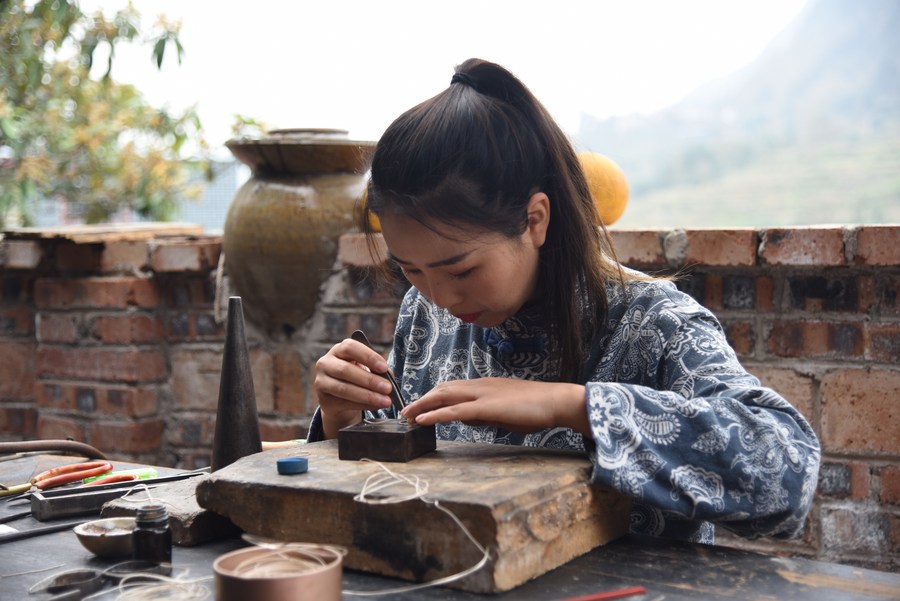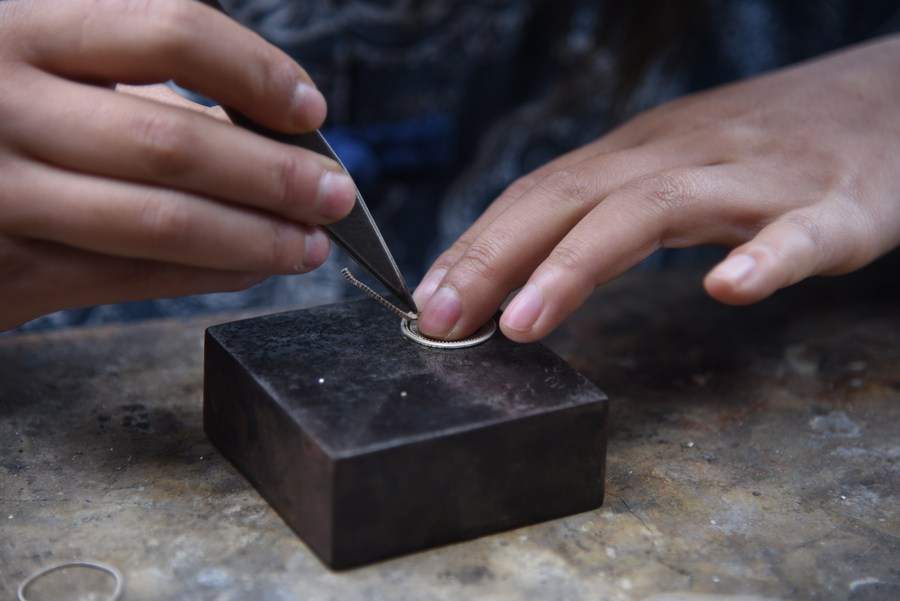
Photo taken on Nov. 20, 2020 shows that Pan Xue places a tiny little silver thread inside a silver loop in the village of Shuli, under the city of Kaili, in southwest China's Guizhou Province. (Xinhua/Zheng Minghong)
GUIYANG, Dec. 3 (Xinhua) -- Sitting at an operating platform with a pair of tweezers in hand, Pan Xue places a tiny little silver thread inside a silver loop about 1 cm in diameter.
"This is called thread-adding, which is one of the many steps of making the Miao ethnic silver ornaments," said Pan, 23.
Pan was born and raised in the village of Shuli, under the city of Kaili, in southwest China's Guizhou Province. In her spare time, she records the process of her making ethnic silver ornaments and uploads them on China's popular short-video platforms, such as Douyin and Kuaishou, bringing the traditional craftsmanship to the public gaze.
The ethnic Miao people have a long history of wearing silver ornaments. For them, these ornaments are not just pretty, but also cultural symbols, the intricate pictures on them representing aspects of Miao history.
So far, Pan has uploaded more than 100 short videos online.
"Each individual Miao ornament tells a vivid story," she said. "I hope that, through the videos, people will better appreciate the beauty of Miao culture."
Pan's passion for the Miao silver ornaments began when she was just a child.
"The Miao people have a tradition that every Miao girl inherits a pair of silver ornaments from her parents as dowry," Pan said.
At age 12, Pan's granny took her to a local silversmith to make her dowry, for future use. This was when she realized that all the Miao silver jewelry was made by hand.
"I thought the pretty ornaments must be something created by machines," she said.
Pan was amazed at how the silversmith, Zhang Yongfu, managed to create her future dowry "out of nowhere."
"From that point on, I often went to Zhang's shop to watch him craft silver ornaments, and I helped him occasionally," she said. "At that time, I began to want to learn the skills systematically."
In 2016, Pan graduated from high school and chose music as her major in college. But every summer and winter holiday, she would go to Zhang's shop to learn how to make the silver ornaments as a part-time job.

Photo taken on Nov. 20, 2020 shows that Pan Xue places a tiny little silver thread inside a silver loop in the village of Shuli, under the city of Kaili, in southwest China's Guizhou Province. (Xinhua/Zheng Minghong)
During her college years, Pan was constantly promoting her ethnic culture by uploading videos of herself dressed in the Miao costumes, playing the Lusheng -- a reed-pipe wind instrument -- and making Miao silver ornaments. The videos grabbed people's attention on the Internet, and some netizens wrote comments below the videos, saying they loved the Miao traditions.
Pan was inspired by the feedback, and after careful consideration, she decided to learn how to make silver ornaments professionally, with a view to passing on the craftsmanship. In August 2018, she officially became Zhang's apprentice.
"Making the Miao ornaments was definitely not as easy as I thought," Pan said.
She is a fan of manicures, but to master the skills of ornament making, she cut all her fingernails short.
After graduating from college this year, she finally committed to becoming an artisan within her chosen field, although she initially hid the decision from her parents.
"It was a tough decision for me," she said. "My parents had always wanted me to find a more 'decent, stable' job."
Her parents did not know their daughter's chosen trade until media people came round to interview her, informing them in the process.
"They love the traditional culture, so they voiced no objections," Pan said.
The COVID-19 epidemic caused many silversmith shops to halt operations, including Zhang Yongfu's. So, Pan resorted to the Internet, posting videos and live-streaming about the traditional ornaments.
Once orders starting coming in, she shared them with silversmiths like Zhang. From early February to mid-April, Pan received more than 500 orders worth 115,680 yuan (17,606 U.S. dollars).
"If it weren't for Pan, I would not have any business this year," Zhang said.
After two years of professional training, Pan has become quite skillful. She often watches online training courses and studies the works of masters in the industry.
"Innovation is important if we want to make traditional stuff more interesting," she said. "I am still learning in this regard." ■



